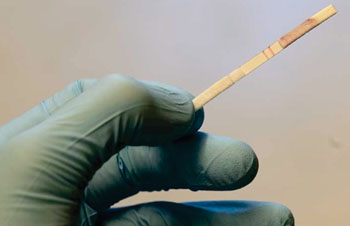Paper Based Urine Test Detects Cancer
By LabMedica International staff writers
Posted on 13 May 2014
A technology that combines synthetic biomarkers with a paper-based urine test can detect colorectal cancer and thrombosis in just a few minutes.Posted on 13 May 2014
The new technique uses exogenous agents injected into the patient, which bind with tumor proteins. A paper strip test then easily detects the synthetic biomarkers in the patient’s urine and the molecular detection system brings a number of existing technologies together in a novel way.

Image: Typical lateral flow paper strip device (Photo courtesy of Massachusetts Institute of Technology).
Scientists at the Massachusetts Institute of Technology (MIT; Cambridge, MA, USA) developed nanoparticles that target diseased tissue, such as a tumor, at which point reporter compounds that had been bound to the nanoparticles are released and cleared into the urine. They designed two synthetic biomarkers, one associated with colorectal cancer and another that was specific to blood clots, a common sign of cardiovascular problems. The team demonstrated their ability to detect these compounds in urine from murine models of these diseases using a paper strip coated with targeted antibodies, a strategy called paper lateral flow assay (LFA).
The investigators focused on one group of signals called matrix metalloproteinases (MMPs), because MMPs function to help cancer cells to metastasize. They printed capture antibodies into four parallel test lines relative to a control line and analyzed urine samples that contained one of the four reporters. Similar to the enzyme-linked immunosorbent assay (ELISA) results obtained previously, only the test lines printed with the cognate capture antibody developed a positive signal, highlighting the LFA’s specificity and the capacity to detect distinct reporters with single spatially encoded paper strips.
Sangeeta Bhatia, MD, PhD, a professor and senior author of the study said, “When we invented this new class of synthetic biomarker, we used a highly specialized instrument to do the analysis. For the developing world, we thought it would be exciting to adapt it instead to a paper test that could be performed on unprocessed samples in a rural setting, without the need for any specialized equipment. The simple readout could even be transmitted to a remote caregiver by a picture on a mobile phone.” The study was published on February 24, 2014, in the Proceedings of the National Academy of Sciences of the United States of America (PNAS).
Related Links:
Massachusetts Institute of Technology














